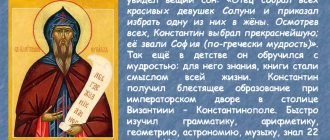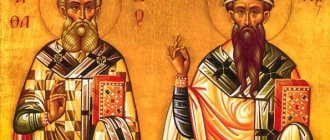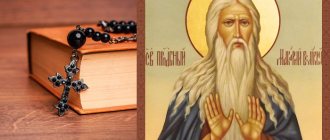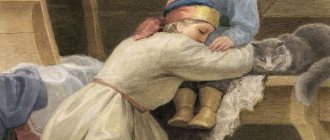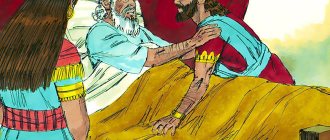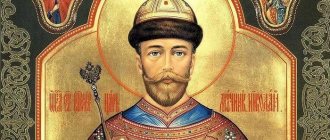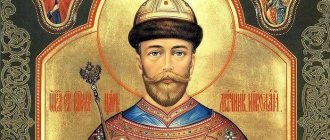Emperor Constantine the Great, commemorated June 3
He was the son of Saint Helen Equal to the Apostles and Constantius Chlorus, who ruled part of the Roman Empire in the West. From a young age, Constantine was taken away from his parents, and he began to live at the court of Emperor Diocletian. In 306, the ruler abdicated the throne, then Constantine returned to his native Gaul, where he was proclaimed emperor.
In 312 he fought against Caesar Maxentius. On the eve of the decisive battle, Constantine saw a cross in the sky with the inscription: “With this (this) conquer.” At night, the Savior himself appeared to the emperor in a dream with the sign of the cross. And he told him that it was with the sign of the cross that the enemy would be defeated.
In the morning, the emperor ordered all soldiers to make images of the Holy Cross. And the victory was won. After this, he entered Rome and ordered a statue with a cross in his right hand to be erected in the central square, and then issued a manifesto allowing people to accept Christianity without fear. He also returned the buildings of liturgical meetings to the believers.
| Meanwhile, the relationship between the emperor and his co-ruler Licinius turned into an open struggle, which was supposed to decide the fate of Christianity. In the Battle of Adrianople, Constantine won, and Licinius lost his throne and life. After this, Emperor Constantine became the only ruler of the Roman Empire in which Christianity triumphed. The emperor devoted his entire life to serving God and the Church. All laws, services, and social order were guided by the foundations of Christianity. He stopped pagan games, abolished execution by crucifixion, freed the clergy from general taxes, forbade making sacrifices to idols, and ordered the construction of Christian churches. In Rome, the emperor felt great resistance from the pagans. He decided to leave the city and found a new capital on the banks of the Bosphorus - Constantinople. One of the great merits of the emperor was the organization of the First Ecumenical Council. This happened in 325 in the city of Nicaea. Until the last days of his life, Saint Constantine postponed accepting Baptism. When he felt the approach of death, he accepted this Sacrament with special reverence. On May 21, 337, he peacefully departed to the Lord during prayer. | Icon of Emperor Constantine the Great |
Icon of the Equal-to-the-Apostles St. Konstantina and Elena what helps and meaning
"Save me, God!". Thank you for visiting our website, before you start studying the information, please subscribe to our Orthodox community on Instagram, Lord, Save and Preserve † - https://www.instagram.com/spasi.gospodi/. The community has more than 60,000 subscribers.
There are many of us like-minded people and we are growing quickly, we post prayers, sayings of saints, prayer requests, and timely post useful information about holidays and Orthodox events. Subscribe. Guardian Angel to you!
Saint Helena is the mother of Saint Constantine the Great, Equal-to-the-Apostles, a Christian educator, thanks to whom Christianity became the state faith and was freed from all persecution.
Venerable Konstantin Kosinsky, memorial date: August 11
Another saint is St. Konstantin Kosinsky, Starorussky. He and his associate Cosmas were disciples of the Monk Varlaam of Khutyn. In 1220, they left the Khutyn monastery and retired to the peninsula, which was located near the city of Staraya Russa, and founded a monastery there in honor of St. Nicholas of Myra. Until his death, the Monk Constantine was the abbot of the monastery.
After his death, his successor, the Monk Cosmas, continued his asceticism.
Both saints are buried under the porch of the St. Nicholas Church.
Icon of St. Konstantin KosinskyWars
Young Constantine enlisted in the army in Nicomedia and took part in campaigns in Egypt and Persia. In 305, his father, who had become emperor in the western part of the country, summoned his son to help him in the British battle against the Picts. When Constantius died a year later, the troops immediately recognized Constantine as the legal heir, but officially he received only the status of Caesar.
Constantius appoints Constantine as his successor
At that moment, 6 people claimed the title of the main leader of the empire, which caused political strife. In 307, Constantine secured the throne by marrying Fausta, the daughter of his main rival Maximilian. He later attempted to illegally seize power, after which he was forced to commit suicide. Constantine also removed the remaining rivals by arranging profitable marriages and other political intrigues.
Orthodox saints named Constantine
Below we provide a list of saints named by the Orthodox male name Constantine.
Memorial days are indicated in the new style so that you can choose the boy's patron saint by the date closest to his birthday.
- Konstantin (Aksyonov), priest, schmch., 04.02, 22.10
- Konstantin (Bazhanov), archpriest, schmch., 04.02, 23.12
- Konstantin (Bogoslovsky), archpriest, schmch., 04.02, 02.10
- Konstantin (Epiphany), priest, schmch., 04.02, 27.07
- Konstantin (Golubev), archpriest, schmch., 04.02, 02.10, 20.11
- Konstantin (Zverev), deacon, schmch., 04.02, 11.02
- Konstantin (Kolpetsky), priest, schmch., 04.02, 23.09
- Konstantin (Lebedev), priest, schmch., 04.02, 22.07
- Konstantin (Lyubomudrov), priest, schmch., 04.02, 19.11
- Konstantin (Minyatov), martyr, 04.02, 29.06
- Konstantin (Mikhailovsky), archpriest, schmch., 04.02, 02.12
- Konstantin (Nekrasov), priest, schmch., 04.02, 15.12
- Konstantin (Nemeshaev), priest, schmch., 04.02, 22.11
- Konstantin (Popov), priest, schmch., 04.02, 26.08
- Konstantin (Pyatikrestovsky), archpriest, schmch., 04.02, 06.03
- Konstantin (Razumov), priest, confessor, 04.02, 20.06, 13.08
- Konstantin (Slovtsov), priest, schmch., 04.02, 02.08
- Konstantin (Sokolov), priest, schmch., 04.02, 25.03
- Konstantin (Sukhov), priest, schmch., 04.02, 22.10
- Konstantin (Tverdislov), priest, schmch., 04.02, 01.10
- Konstantin (Uspensky), archpriest, schmch., 04.02, 25.11
- Konstantin (Chekalov), priest, schmch., 04.02, 03.11
- Konstantin (Cherepanov), priest, schmch., 04.02, 22.11
- Konstantin (Shirokinsky), priest, schmch., 04.02, 04.10
- Konstantin (Yurganov), priest, schmch., 04.02, 15.11
- Konstantin see: Exacustodian,
- Constantine see: Kirill the Philosopher
- Constantine of Ammore (Phrygian), martyr, 19.03
- Konstantin Aragvetsky, prince, martyr, 15.10
- Konstantin Vsevolodovich Yaroslavsky, prince, 05.06, 21.06, 16.07
- Konstantin Gruzinsky, prince, martyr, 23.11
- Konstantin Kosinsky, Starorussky, Ave., 11.08
- Konstantin Sinadsky (Phrygian), St., 08.01
- Saint Constantine, Metropolitan of Kiev and All Russia, 18.06
- Holy Blessed Prince Konstantin Yaroslavsky, 18.03, 05.06, 02.10
- Holy Blessed Prince Konstantin of Murom, 03.06
- Holy Equal-to-the-Apostles King Constantine, 03.06
Description of the holy image
Lifetime images of the queen’s image, her sculpture and coins with a profile have survived to this day. Of course, in these images the queen’s facial features are slightly distorted, but they still correspond to reality.
They began to venerate the Saint immediately after her death, and several centuries later the first icon with her face was painted. Over time, a special tradition developed regarding exactly how to depict Elena on icons. Very rarely a woman is depicted alone on icons; as a rule, she is always together with her son, who stands on her left hand, and there is a cross between them.
There are also images with hagiographical stamps and small miniatures showing scenes of the main events in the life of the saint: the vision, the journey to the Holy Land and the finding of the Cross of the Lord.
Who were Konstantin's parents?
The saint's father is known to historians as Constantius the First Chlorus. He seized the throne in 293, and received the nickname “Chlorus” for his pale skin. This man founded the Constantine dynasty and was very popular among the military. He died suddenly, without completing the punitive military campaign. Such a death caused a crisis in the country known as the "tetrarchy". In other words, the power of four people bearing the title of tetrarchs. Emperor Diocletian introduced this concept. Because of this crisis, Constantine's rise to power was carried out through numerous military skirmishes, battles, in fact, events not much different from a civil war.
Constantine's mother, Helen, revered in Christianity along with her son, was not his father's wife. This is an unprecedented case of canonization, and in such a rank, of a woman who spent her life in sin. Elena was a concubine. This is how in Rome they called women of low origin who cohabited with men outside of marriage, who were supported, but who were not harlots. Children born in such unions had no rights to property, status, titles, etc. Of course, such a nuance also complicated Constantine’s rise to power no less than the political crisis and the four tetrarchs with the troops supporting them.
Prayer to Saint Nina in Russian
Saint Nina Equal to the Apostles - Memorial Day January 27th.
What do they pray to Saint Nina Equal to the Apostles?
In addition to the fact that Saint Equal-to-the-Apostles Nina is the patroness of all who are baptized with the same name, she helps everyone who asks her for intercession.
Nina is considered the patroness of those people who are associated with education (teachers), because in essence she was an educator, teaching people the faith of Christ.
In front of the icon of Saint Equal-to-the-Apostles Nina, you can pray for the cure of various diseases and mental ailments - her most important weapon was a cross made of grapevine, which she received from the Mother of God Herself.
In Georgia, a lot of girls are named Nina - after all, the saint is considered the patroness of this country and its inhabitants. It must be remembered that icons or saints do not “specialize” in any specific areas. It will be right when a person turns with faith in the power of God, and not in the power of this icon, this saint or prayer.
Which saints and who should we pray to on different occasions and why our prayers remain unanswered.
Life of Saint Nina, enlightener of Georgia
Saint Nina was born around the year 280 in Cappadocia (the center of modern Turkey) into a noble family. Her father Zabulon was a noble nobleman, he was favored by the ruling emperor Maximian himself. There were several famous saints in this family, Zebulon had a relative - the Holy Great Martyr George the Victorious, and Saint Nina herself was his cousin.
At the age of twelve, Saint Nina found herself in Jerusalem with her parents. Her father Zebulon became God's servant in the Jordanian deserts, and her mother, Susanna, had the great honor of serving at the Church of the Holy Sepulcher.
Saint Nina was raised by the pious Elder Nianfora, who taught her to follow numerous rules of faith and instilled in her a love of reading the Holy Scriptures.
One day she was reading the Gospel and thinking about the Robe of the Lord (John 19:23-24). Nianfora told her the legend that the Mtskheta rabbi Eleazar took the sacred Robe of the Lord to Iveria (Georgia), which became one of the Destinations of the Mother of God.
The enlightenment of Iberia fell to Saint Mary by lot with the apostles, but the Angel of the Lord who appeared to her said that Georgia would be Her destiny after the end of her earthly life, and during her life, according to the Providence of God, She was to place Her holy labors on Athos.
Having learned this story from Elder Nianfora, Saint Nina began to fervently pray to the Most Holy Theotokos to help her enlighten Georgia and suggest the location of the Robe of the Lord, which had been lost to people. And then one day, in a dream, the Mother of God appeared to the righteous woman and said to her:
- “Take this cross, it will be your shield and fence against all visible and invisible enemies. Go to the country of Iveron, preach the Gospel of the Lord Jesus Christ there and you will find grace from Him: I will be your Patroness.”
- With these words, the Blessed Virgin presented Nina with a cross made of grapevine, which the girl, upon waking up, saw in her hands.
- Currently, this grape cross is in a special ark in the Tbilisi Zion Cathedral.
When Saint Nina told her uncle, who was the Patriarch in Jerusalem, about this, he without hesitation blessed her for apostolic service, after which she went to Iberia, where she arrived in 319.
She fell in love with the local people, studied their customs, language and preached Orthodoxy, while her sermons were accompanied by many signs.
Once in the city of Mtskheta (the capital of ancient Georgia) there were pagan celebrations and at the same time the Christian holiday of the Transfiguration of the Lord began. On this day, during the prayer of St. Nina, a very strong wind arose, blowing away the idols to which people made sacrifices and prayed to them.
In Mtskheti, Saint Nina found shelter in the family of the royal gardener. For many years there were no children in this family, and now, through the prayers of Saint Ninoy, this man’s wife, Anastasia, was finally able to give birth to a child and immediately believed in Christ.
A little later, Saint Nina helped the Georgian Queen Nana overcome a serious illness, after which she turned from an idolater into a zealous Christian and accepted Baptism. Nana's husband, King Miriam (265-342) saw, of course, the miraculous healing of the queen, but, despite this, he believed the evil slander against Nina.
He ordered her to be seized and executed, but during the execution of the holy righteous woman, the sun suddenly darkened and darkness fell. The ruler was struck by blindness, and his courtiers began to pray to their pagan gods for day to return to them. But their, as they thought, “holy” idols remained and did not help and the darkness intensified.
Then the frightened people cried out to the Lord God, whom Nina preached, and immediately the darkness dissipated and the sun came out. This happened in 319 on May 6th.
What to pray for in front of his icon?
Who does Saint Constantine help and with what? The icon and prayer to him will protect him from misfortunes in business, business, and when communicating with government officials. The saint patronizes people who are strategists, regardless of the field in which they work. Helps bring plans to life.
Here is a small list demonstrating what it is customary to pray for to the holy icon of Constantine:
- material wealth, prosperity, stability and growth in business and career;
- assistance in new beginnings, business projects;
- success in social activities and in the political field.
Of course, they turn to the saint with other requests. But, as a rule, they do not ask Constantine to grant personal happiness and other similar things.
Source of the article: https://fb.ru/article/448696/v-chem-pomojet-ikona-svyatogo-konstantina-ob-imperatore-ego-roditelyah-i-zaslugah-pered-hristianami
Shining victory cross in the sky
The persecution of Christians continued for about 250 years and stopped only under Emperor Constantine the Great, who himself accepted the Christian faith. From childhood, Constantine the Great was raised by his mother, Queen Helena, to respect Christians.
Upon ascending the imperial throne, he had to endure a stubborn struggle with two rivals, Maxentius and Licinius, enemies of Christians.
Before the decisive battle with Maxentius, Constantine and his soldiers saw a shining cross in the sky, as if made up of stars, and above it the inscription: “By this conquer.”
At first this wonderful vision caused confusion in Constantine. What could it mean? But later the Lord Himself appeared to the emperor in a dream and ordered him to make a banner similar to the one that was seen in heaven. The Lord promised Constantine victory.
Constantine fulfilled the command: he put an image of the cross on his banners and won a complete victory over Maxentius.
When Constantine became sovereign emperor, the capital of the state was moved from Rome to Byzantium. Soon the city of Byzantium itself was renamed Constantinople.
Great and blessed in the eyes of Christians are the deeds of Constantine. He not only made it possible to freely profess the Christian faith, but built many churches and took care of the spread of Christianity throughout the country. Throughout the empire, Sundays and Christian holidays began to be celebrated. The death penalty by crucifixion was abolished.
Equal to the Apostles Constantine and Helen
